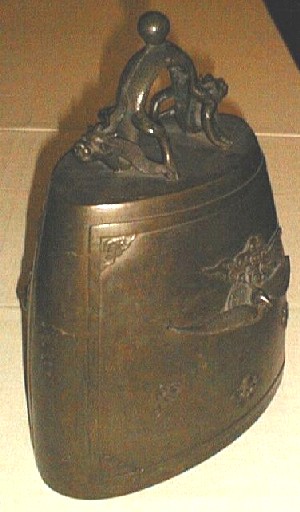Ancient Chinese Bells
Today, some 2000-year-old bells reveal a secret. The University of Houston's College of Engineering presents this series about the machines that make our civilization run, and the people whose ingenuity created them.
Just after the turn of this century, archaeologists started finding curious sets of bronze bells in tombs throughout China. They range from 2000 to 3600 years old, and they have an odd shape. They look like truncated cones that've been slightly squashed -- something like our cowbells -- but they don't have clappers. They were meant to be struck. They're called Zhong bells. Thousands of these bells had been unearthed by the late 1970s, and their strange secret still hadn't yet come to light.
The secret was actually seen and missed in 1957 when the National Music Research Institute in China played a set of these bells in concert. The players were rehearsing a piece with the unpromising title The East is Red. The E-bell was missing in one octave. But then a player found he could get that sound by striking the C-bell on its side. He found that the bell played two tones, a third apart.
That was taken as a coincidence. But twenty years later, Chinese musicologists, examining a set of these bells, discovered that every bell in the set had the same property -- it had two tones, either a third or a minor third apart. Then they found that many of these bells even had marks on the side to show players where to strike the bells to get the two tones. Each bell was, in fact, meant to be two bells in one.
The importance of this discovery is clearer if we realize that the Western cathedral bell was the result of a thousand years of development. Bells are very hard to make. Yet these much older Zhong bells are remarkably sophisticated. They have a rich tone, but they need far less bronze to get it. And then they produce two sounds for the cost of one. We have nothing like them in our vast instrumental armory today.
Acousticians are just now coming to understand how they work. Musicians are finding they were really quite hard to play. And yet this technology -- which also took a thousand years to perfect -- completely died out during the Han period -- during the rise of the Roman Caesars. It was a remarkable technology and a remarkable art. Yet it completely vanished.
It's easy to look right at something that's very sophisticated without seeing the sophistication. It took us eighty years to catch on to these remarkable, but unassuming, bells. The best inventions are like that. In the best inventions, elegance masquerades as simplicity.
I'm John Lienhard, at the University of Houston, where we're interested in the way inventive minds work.
(Theme music)
Fletcher, N. H., Rossing, T. D., The Physics of Musical Instruments. New York: Springer-Verlag, 1991, Chapter 21, Bells.
Temple, R., The Genius of China. New York: Simon & Schuster Inc., 1986, pp. 199-201.
This episode has been greatly revised as Episode 1676.

(Photo by John Lienhard)
I was shown this ancient Chinese bell in the Yale University Collection of Musical Instruments. Since it sounds two different pitches, depending upon where it is struck, I am fairly certain that it is a Zhong type of bell.